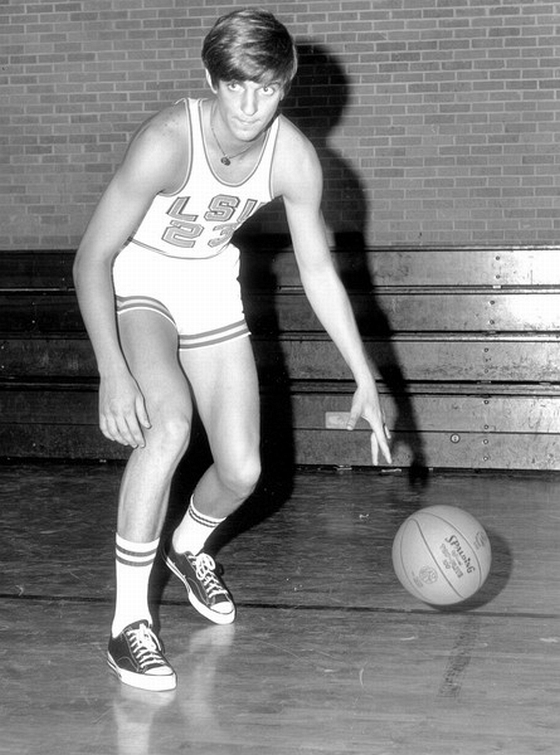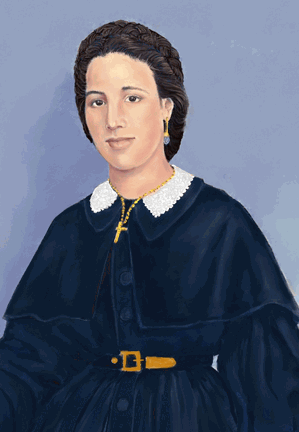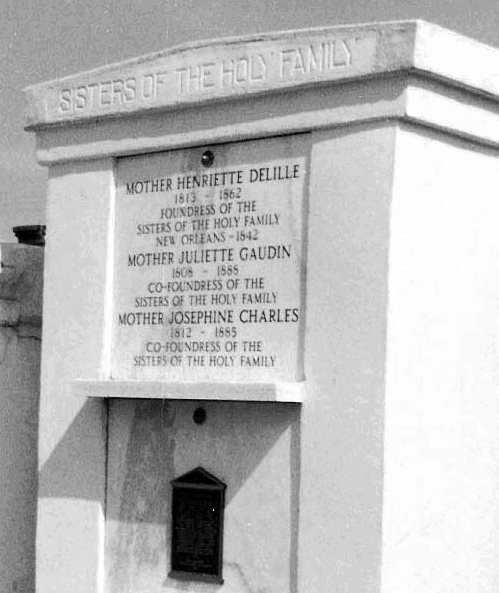|
Today in New Orleans History |
|
|
June 22


 Pistol Pete Maravich is Born Peter Press "Pistol Pete" Maravich was born on June 22, 1947 in Aliquippa, Pennsylvania.
His father, Petar "Press" Maravich, was a professional basketball player then coach at Clemson University, North
Carolina State University, and LSU. While in high school the younger Peter acquired the nickname "Pistol
Pete" because he often shot the ball from his side in a motion which resembled shooting a hand-gun. For three years of
his college career at LSU, his father was the varsity coach. Pete was selcte by the Atlanta Hawks as a third pick
in the first round of the 1970 NBA Draft. In the summer of 1974, he moved to the expansion franchise New Orleans Jazz.
When the team moved to Salt Lake City in 1979 to become the Utah Jazz, Pete moved with them. In January 1980 he moved to the
Boston Celtics. Ongoing knee problems led to his retirement at the end of that season. He was the all-time
leading NCAA Division I scorer with 3,667 points scored and an average of 44.2 points per game achieved before the three-point
line was introduced to NCAA basketball and despite being unable to play varsity as a freshman under then-NCAA rules. One of
the youngest players ever inducted into the Naismith Memorial Basketball Hall of Fame, Maravich was cited by the Hall as "perhaps
the greatest creative offensive talent in history". In an April 2010 interview, Hall of Fame player John Havlicek said
"the best ball-handler of all time was (Pete) Maravich." On January 5, 1988, Pete Maravich
collapsed and died at age 40 of heart failure while playing in a pickup basketball game in the gym of a church in Pasadena,
California, with a group that included evangelical leader James Dobson. Maravich had flown from his home in Louisiana to
tape a segment for Dobson's radio show. An autopsy revealed the cause of death to be a rare congenital
defect; he had been born with a missing left coronary artery, a vessel which supplies blood to the muscle fibers of the heart.
His right coronary artery was grossly enlarged and had been compensating for the defect. Maravich is buried at Resthaven Gardens
of Memory and Mausoleum in Baton Rouge. (WIKI)  

To receive an update for each day in New Orleans
history, join our facebook page
- Today in New Orleans History
Tweet
Walter Stauffer McIlhenny (October 22, 1910 - June 22, 1985) served as president
of McIlhenny Company, maker of Tabasco brand pepper sauce. Around 1940, when he began executive training at the company at
Avery Island. McIlhenny's grandfather, Edmund McIlhenny, had invented the fiery condiment, and his father, John Avery McIlhenny,
had presided over the company from 1890 to 1898. After sering with distinction in World War II, he returned to the organization
in 1946, assumed its presidency in 1949, and retained that office until his own death in 1985. During his tenure as head
of the company, McIlhenny expanded and modernized the production and marketing of Tabasco brand pepper sauce and helped to
mold the brand into an international culinary icon.
Born in New Orleans on June 22, 1962, Clyde Austin "The Glide" Drexler
was a professional basketball player who was a ten-time All-Star, was named one of the 50 Greatest Players in NBA History,
won an Olympic gold medal in 1992 as part of the 1992 United States men's Olympic basketball team ("The Dream Team"),
and an NBA Championship player in 1995 with the Houston Rockets. He is a two-time Naismith Memorial Basketball Hall of Fame
inductee (being inducted 2004 for his individual career, and in 2010 as a member of the "Dream Team"). (WIKI)
Paul Morphy was born on June 22, 1837 in what is now known as the Beauregard-Keyes House
and museum at 1113 Chartes St. The house was built in 1826 and was later owned by General Pierre
Beauregard in 1866 and by author Frances Parkinson Keyes from 1942 to 1970. Born into wealth and class Morphy was a child
prodigy, beating Hungarian chess master Johann Löwenthal when the boy was 12 years old. At
age 20, he won the First American Chess Congress and held the title "Chess Champion of the United States".
Shortly afterward Morphy was declared "The World Chess Champion" and retired from the
game. In later life, Morphy suffered with depression and mental illness. In 1841, the family moved
to 417 Royal Street to the home where he died on July 18, 1884 of a probable stroke. This property later became Brennan's
Restaurant. CITY ORDINANCE To decrease the number of dogs in New Orleans and its
incorporated Faubourg. And
To farm said tax's proceeds. ARTICLE 1st ARTICLE 2nd The purchaser shall as soon as he has signed his contract and given
the above mentioned note, take or have a census taken of all canines in the indicated limits giving the name of each said
canine owner. Anyone refusing to acknowledge ownership of a dog; or making a false statement shall pay a $5.00 fine for
each violation whose collection shall be made in any competent court one half to the benefit of the purchaser, the other
1/2 to the benefit of the City Funds. ARTICLE 4th Before next August 1st, all
canine owners shall receive brass or metal collars on which the name and address of their owner shall be inscribed. Any
canine found without said collar in the streets or public places after next August 1st, shall be taken and done away with
as the purchaser or his agent shall see fit without prejudice to the rights of the purchaser, to have the tax on said animals
paid to him should said tax not be paid. ARTICLE 5th It is strictly prohibited
that slaves shall own a canine. In the event of violation of the present Ordinance, the tax on above mentioned animals
shall be paid to the purchaser by said slave's master unless the latter shall prefer to have them lashed at the jail by not
more than ten lashes. Notwithstanding that said animals shall be done away with as the purchaser or his agent shall see
fit. ARTICLE 6th The purchaser shall give the Mayor the first two weeks of April
of each year and exact copy of the census he shall have taken for said year of all said animals in the City and incorporated
Faubourgs. He shall also state the number of said animals he shall have done away with by virtue of the present Ordinance.
Approved, June 22, 1832 D. Prieur, Mayor
A New Orleans
lady, born in 1813 to a wealthy Frenchman and a quadroon free woman of color, who rejected the social norms of her times is
now the first U.S. native-born African American religious leader whose cause for canonization was officially opened by
the Catholic Church. Six years later, at the urging of Jeanne Marie Aliquot (an early supporter of St. Augustine Church)
and the counseling of Pere Etienne Rousselon (vica-general of the diocese), Delille and Gaudin knelt publicly at the
altar of St. Augustine Church on November 21, 1842 and pledged to live in community to work for orphan
girls, the uneducated, the poor, the sick and the elderly among the free people of color, thus founding the Congregation
of the Sisters of the Holy Family -- the second-oldest African-American congregation of religious women. In
1843, catechism classes were conducted for adults and children on St. Augustine's property at Bayou Road (now Governor Nicholls).
Delille and Gaudin were later joined by Josephine Charles; the first three novices, Delille, Gaudin and Charles, are considered
the founders of the congregation. Although the primary work of the sisters was in the area of education, during her tenure
as head of the order, Delille made it possible for the order to build a home for the sick, aged, and poor Black residents
of the city. The photo
above was taken by Sister Doris Goudeaux in 2008 of the three founding members' tomb in St. Louis Cemetery No. 2.
In summing up Henreitte Delille's life and mission, Sylvia Thibodeaux, a modern Sister of the Holy Family, told the
Los Angeles Times, "She was the servant of slaves. You can't get more committed than that. |
|
|

To receive an update for each day in New Orleans history,
join our facebook page - Today in New
Orleans History.
Analytics |

 Henriette Delille's birth was the results of a placage, an extralegal "common law" system which became
institutionalized in our city during the Colonial Era. The arrangements included contracts or negotiations between white
men and free women of color which stipulated the financial and/or housing arrangements for woman, the settlement of property,
and, many times, paternal recognition of any children the union produced. The woman's mother usually negotiated the terms
of the agreements, including the financial payment to the parent. To our modern sensibilities, such arrangements
seem arcahaic but they were acceptable in their day and provided mixed-race women with social prestige and financial security.
Henriette Delille's birth was the results of a placage, an extralegal "common law" system which became
institutionalized in our city during the Colonial Era. The arrangements included contracts or negotiations between white
men and free women of color which stipulated the financial and/or housing arrangements for woman, the settlement of property,
and, many times, paternal recognition of any children the union produced. The woman's mother usually negotiated the terms
of the agreements, including the financial payment to the parent. To our modern sensibilities, such arrangements
seem arcahaic but they were acceptable in their day and provided mixed-race women with social prestige and financial security.
 Henriette Delille passed away on November 16, 1862 at the age of 50. It is thought that her
death was a result of tuberculosis. Her funeral was held at St. Augustine church. She is buried in St. Louis Cemetery
No. 2.
Henriette Delille passed away on November 16, 1862 at the age of 50. It is thought that her
death was a result of tuberculosis. Her funeral was held at St. Augustine church. She is buried in St. Louis Cemetery
No. 2. 
